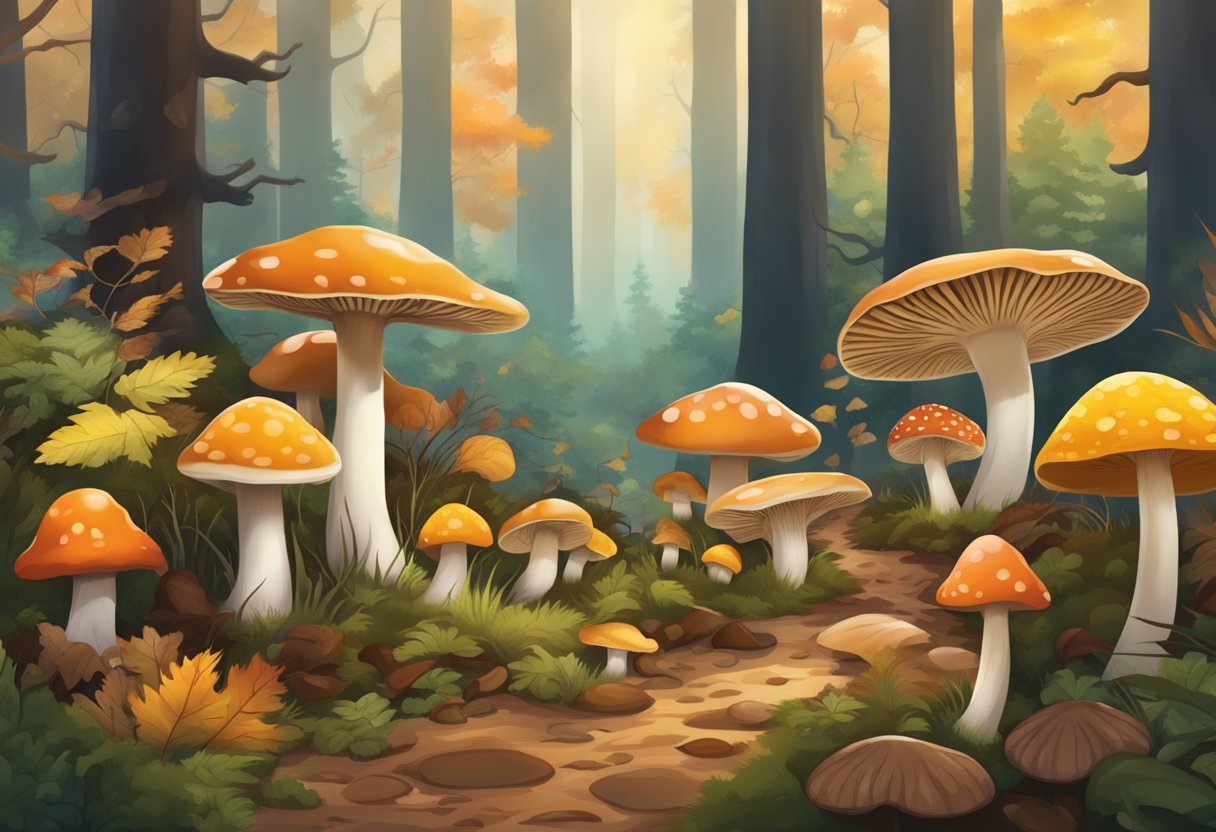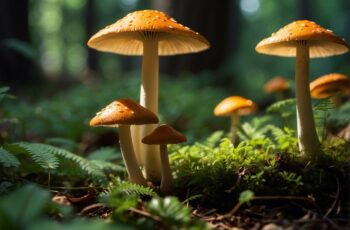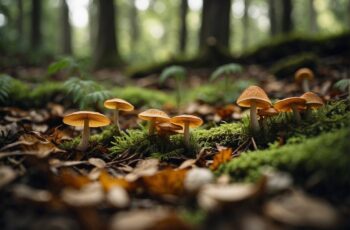The season for mushrooms is a period that excites both chefs and foragers, marking a time when an array of wild mushrooms become available for culinary use and enjoyment. Depending on the region, the mushroom season can vary, but it typically spans from late summer through early winter in areas such as the Pacific Northwest. The environment during these months provides the ideal combination of moisture, temperature, and nutrients in the soil to support the growth and proliferation of various mushroom species.

Understanding the seasonality of mushrooms is important not just for locating them in the wild but also for appreciating their peak flavor and texture when used in cooking. Each variety of mushroom brings its own unique qualities to the table, and savvy foragers and cooks know that certain types of mushrooms are best harvested and prepared at specific times of the year. This knowledge is crucial for anyone looking to include these fungi in their diet, as it influences both the quality of the mushrooms available and the types of dishes that can be prepared with them.
Key Takeaways
- Mushroom seasons vary by region and influence availability and flavor.
- Distinct mushroom varieties require understanding of individual growth cycles for optimal foraging and cooking.
- Knowledge of mushrooms contributes to both culinary excellence and nutritional benefits.
The Basics of Mushroom Varieties
Mushrooms come in a wide array of flavors and textures, making them a versatile ingredient for an assortment of dishes. Each variety possesses unique characteristics that can enhance a meal’s culinary experience.
Understanding Different Mushroom Types
Mushrooms are classified by their shapes, sizes, and colors, as well as how they grow, their habitat, and edibility. Here’s a brief overview of popular edible mushrooms:
- Morel Mushrooms: Distinctive for their honeycomb appearance, these are prized for their earthy and nutty flavor.
- Oyster Mushrooms: These fan-shaped mushrooms offer a delicate texture and a mildly sweet taste.
- Shiitake Mushrooms: Known for their rich, woodsy flavor and meaty texture, shiitakes are a staple in many Asian cuisines.
- Porcini: A favorite in Italian cooking, porcini mushrooms have a strong nutty flavor and a tender, meaty texture.
- Truffles: These highly sought-after fungi boast an intense, earthy flavor and are often used in small amounts due to their distinct taste and high cost.
- Cremini Mushrooms: Also known as ‘baby bellas,’ these are the same species as white button mushrooms but are more mature, offering a deeper flavor.
- White Button Mushrooms: The most common mushroom, these have a mild taste that can complement almost any dish.
Selecting the Right Mushroom for Your Dish
When selecting mushrooms for a recipe, consider the following aspects:
- Flavor Profile: Match the mushroom’s flavor to the dish’s ingredients. For instance, add shiitake mushrooms to stir-fries for an umami kick, or top pizzas with cremini for a hearty taste.
- Texture: Decide on the desired texture; something like morel mushrooms can add an interesting contrast to a smooth sauce or soup.
- Cooking Method: Some mushrooms, such as portobellos, are robust and can stand up to grilling, while oyster mushrooms are more delicate and suit quick sautés.
By understanding the different types of mushrooms and selecting the right variety for your recipe, you can greatly influence the final flavor and texture of your dish.
Mushroom Preparation Techniques
Preparing mushrooms correctly enhances their flavor and texture. Mastering these techniques ensures mushrooms are sautéed to perfection, with just the right balance of seasoning and heat.
Proper Cleaning and Handling
Mushrooms should be clean before they are cooked. They can absorb water, so it’s best to gently wipe them with a damp cloth or use a soft brush. However, if they’re particularly dirty, a quick rinse and immediate pat dry can be done. Ensure mushrooms are not soaked in water, as they may become waterlogged, affecting their texture when cooked.
Cutting and Slicing
Once cleaned, mushrooms are ready to be cut. Large mushrooms like portobellos work well when sliced, while smaller varieties can be halved or quartered. The goal is uniform pieces for even cooking. Use a sharp knife to cut through the mushroom cap and stem cleanly, which helps preserve the texture and appearance during cooking.
Sautéing Mushrooms Properly
To sauté mushrooms, start with a hot skillet over high heat. Add a combination of oil and butter to create rich flavor and encourage browning. For the best results, cook the mushrooms in a single layer, and don’t overcrowd the skillet. Stir occasionally with a wooden spoon to prevent sticking and to ensure even cooking. Mushrooms are ready when they have a golden-brown crust, usually after about 15 minutes. Finish by seasoning with salt and black pepper to taste. For an aromatic twist, consider adding a bit of garlic butter in the final minutes of cooking.
Mushroom-Centric Recipes
Mushroom recipes offer a wide range of flavor profiles, from the earthy tones of shiitake to the robust essence of portobello. Fresh mushrooms can elevate the simplest dish to something memorable with the right seasonings and pairings.
Mushroom Side Dishes
Mushrooms, with their versatile nature, can be transformed into mouth-watering side dishes that complement any main course. Sauteed garlic and shallots can serve as a flavorful foundation. Here are a couple of options:
- Garlic Butter Mushrooms: A quick sauté with garlic and fresh parsley can turn button mushrooms into a delectable side dish.
- Cheesy Shiitake and Parsley Bake: A sprinkle of cheese and a dash of lemon on shiitake mushrooms make for a satisfying au gratin.
Main Courses with Mushrooms
In the realm of main dishes, mushrooms are as central as proteins like steak or chicken. Integration of flavors is key to these hearty meals. Examples include:
- Rosemary Mushroom Risotto: Perfect for an elegant dinner, fresh rosemary and creamy arborio rice bring out the umami in mushrooms.
- Chicken and Mushroom Pasta: A classic, where tender chicken pieces meet the rich flavor of mushrooms in a savory garlic-infused sauce.
Condiments and Mushroom Flavors
Enhancing dishes with mushroom-based condiments adds depth without overwhelming the primary ingredients of a meal. Here’s a sample idea:
- Wild Mushroom Sauce: Ideal for pork or steak, this rich sauce combines various mushrooms, reduced with shallots and seasoned with a hint of rosemary.
Using these recipes and preparation methods, cooks can transform fresh mushrooms into a centerpiece or complementary element of any meal.
Health Benefits and Nutritional Information
https://www.youtube.com/watch?v=CLhG6f4Unps&embed=true
Mushrooms are a powerhouse of nutrients, offering a range of essential vitamins and minerals, while being low in calories and rich in protein and fiber. The following subsections will delve into the nutritional content of mushrooms and the benefits they provide when included in a diet.
Mushroom Nutritional Profile
Mushrooms have a unique nutritional profile. A one-cup serving of raw mushrooms contains approximately 15 calories and provides 2.2 grams of protein and 2.3 grams of carbohydrates, with a negligible 0.2 grams of fat. These fungi are a valuable source of several B vitamins, copper, potassium, and iron. The absence of sugar, saturated fat, cholesterol, and sodium makes them an excellent food choice for various dietary considerations.
| Nutrient | Amount |
|---|---|
| Calories | 15 |
| Protein | 2.2g |
| Carbohydrates | 2.3g |
| Fat | 0.2g |
| Fiber | Nearly 1g |
| Potassium | Varies |
| Iron | Varies |
| Vitamins | B-complex, including |
(Information adapted from Verywell Fit about Mushroom Nutrition Facts)
Dietary Considerations and Mushroom Benefits
For individuals monitoring their caloric intake or looking to lose weight, mushrooms are an ideal option due to their low-calorie count. The fiber content not only aids in digestion but also helps in keeping one satiated. Mushrooms are also known for their protein content, making them a fitting component of vegetarian and vegan diets.
The presence of key nutrients can contribute to several health benefits. The potassium in mushrooms helps maintain healthy blood pressure, while the iron content is vital for blood formation. Additionally, the B vitamins found in mushrooms, such as riboflavin and niacin, are crucial for the skin, the nervous system, and maintaining energy levels.
An examination conducted by the Cleveland Clinic shows that mushrooms can also have compounds that support overall health and may aid in disease prevention, thanks to the antioxidants present, which combat free radicals in the body.
(Adaptation from Cleveland Clinic’s resource on the Health Benefits of Mushrooms)
Frequently Asked Questions
In this section, readers will find answers to common queries about mushroom foraging and cultivation seasons across various locations.
When is the peak season for mushroom foraging in Oregon?
The peak season for mushroom foraging in Oregon typically ranges from late summer through late fall, as these months provide the ideal wet and mild conditions for mushroom growth.
What types of mushrooms can I find in the fall season?
During the fall season, foragers can find a variety of mushrooms, including popular species like chanterelles, shaggy manes, and hen of the woods, which thrive in the cooler temperatures and moisture of this season.
How long is the mushroom foraging season in Pennsylvania?
In Pennsylvania, the mushroom foraging season spans from spring to late fall, with fall being particularly abundant for wild mushrooms due to the increase in rainfall and cooler temperatures.
What periods are the most fruitful for mushroom hunters in Washington state?
Mushroom hunters in Washington state typically find the most abundant yields during the fall months, especially from September to November, when the climate is most conducive to mushroom growth.
During which months is it best to go mushroom picking in Illinois?
The best months for mushroom picking in Illinois are usually April and May for morels, and then again in the fall for a diverse array of other wild mushroom species.
Is mushroom cultivation possible throughout the year or is it season-dependent?
Mushroom cultivation can often be a year-round activity, especially for varieties like button mushrooms, which are grown indoors under controlled conditions, making them less subject to seasonal changes.


